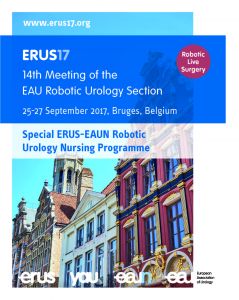ERUS EAUN Robotic Nurse Meeting in Bruges, Belgium, September 2017

 In 2004 a group of physicians gathered in France to look into the latest technology that enabled surgeons to perform surgery with robotic-assisted technique, this meeting became the very beginning of ERUS. This rather new field of performing minimally invasive surgery with the help of a robot was already introduced in 1999, when the first surgical system entered the market.
In 2004 a group of physicians gathered in France to look into the latest technology that enabled surgeons to perform surgery with robotic-assisted technique, this meeting became the very beginning of ERUS. This rather new field of performing minimally invasive surgery with the help of a robot was already introduced in 1999, when the first surgical system entered the market.
Some might say this is the greatest development in medical technology since the laparoscopic boom in the late 1980s and beginning of 1990s. Laparoscopy was a milestone in surgical care and quickly became a popular, widely-used operating technique around the world. The minimally invasive technique led to shorter hospital stay and a more rapid ostoperative recovery for the patient.
Laparoscopy was the precursor to what would again revolutionise the performance in surgical technique robotic-assisted surgery. Superior to laparoscopy, robotic-assisted surgery presented an enhanced vision due to a wider scope, and also enabled the surgeon to work in 3D. Unlike in laparoscopy, the surgeon controls the instruments with an endowrist technique, allowing the instruments to move just like the human hand. Urologists saw the potential in using this technique in urological surgery and embraced the new technology early on. Today, urology surgery is European Association of Urology Nurses one of the surgical specialities that have the longest experience in robotic-assisted surgery.
As a fast-growing field already from the start, the European Robotic Urologic Society became a section within the EAU structure in 2011, and next year the 14th EAU Robotic Urology Section (ERUS) meeting will be held in Bruges, Belgium. ERUS has become the educational platform for urologists to gain in-depth knowledge in roboticassisted urological surgery.
Nurses programme
in 2017, ERUS will also involve nurses working in the operative settings by offering a three-day congress on the three most common urological diseases such as prostate, bladder and kidney cancers. The nurses meeting will start on September 25 with a special nursing programme that includes the nurse´s role in robotic-assisted surgery, lectures on human factors in robotic surgery, team efficiency in the operating room, and how to avoid and manage surgical complications. On 26 and 27 September the regular ERUS live surgery programme will be attended and the nurses’ HOT sessions for less experienced nurses will take place.
The meeting aims to improve the competencies of both junior and senior nurses. Interactive sessions followed by hands-on simulator training and courses will be available for nurses who are seeking a more confident and safe way of working in the operating room during surgery. Prominent urologists will give presentations and provide practical insights.
The ERUS EAUN Robotic Nurse Meeting also aims to build an educational platform for nurses for them to network and actively take part in the latest developments and research in robotic-assisted urology surgery. We expect this meeting to provide crucial skills to nurses, both practical and theoretical, enabling them to take a more active role in the robot-assisted surgical team.
Linda Söderkvist, RNFA, RN, CNOR, MSc., EAUN Board Member, Karolinska University Hospital, Stockholm (SE), l.soderkvist@eaun.org

